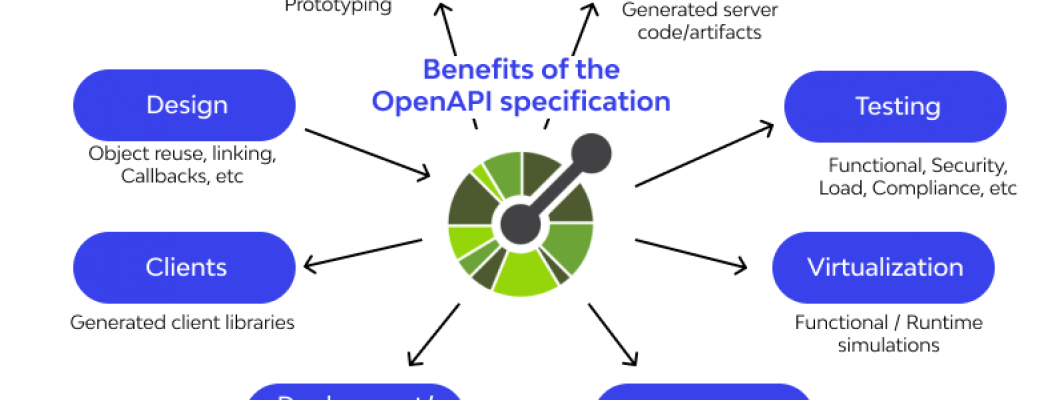
Introduction
In today’s fast-paced world of software development, APIs are the glue that holds applications together. Whether it’s connecting mobile apps to cloud services or linking different microservices within a single platform, APIs need to be reliable, consistent and well-documented.
This is where the OpenAPI Specification (OAS) becomes a game-changer.
OpenAPI helps developers, teams, and organizations standardize their APIs, making them easier to build, understand, and collaborate on — setting the stage for scalable, future-proof systems.
In this blog, let’s dive deep into what OpenAPI Specification is, why it’s important, and how it enhances collaboration and productivity.
What is the OpenAPI Specification?
The OpenAPI Specification is a language-agnostic format for describing RESTful APIs.
Created as the Swagger Specification, it was later renamed and open-sourced under the Linux Foundation to encourage broader adoption.
With OpenAPI, developers write a machine-readable description (in JSON or YAML) of their API's endpoints, request types, response formats, authentication methods, and more — all before or alongside building the actual API.
This "contract-first" approach improves communication between teams and ensures that both front-end and back-end developers — as well as testers and third parties — can understand the API without digging into the source code.
Why Standardization Matters for APIs
Imagine building a house without a blueprint — the construction team, electricians, and interior designers would constantly miscommunicate.
Similarly, without a standardized API contract, different teams might interpret the API differently, leading to costly bugs, inconsistencies, and delays.
OpenAPI brings multiple benefits:
1. Clear Documentation
Instead of relying on outdated manual documents, OpenAPI provides an always-updated, auto-generated, interactive API documentation experience (using tools like Swagger UI or Redoc).
2. Better Collaboration Across Teams
Designers, developers, testers, and third-party integrators can all reference a single, standardized specification. This minimizes confusion and streamlines the handoff between teams.
3. Faster Development with Code Generation
OpenAPI allows the automatic generation of client SDKs, server stubs, and mock servers, accelerating development cycles and reducing manual coding errors.
4. Easier Testing and Validation
Tools like Postman and Dredd can validate APIs against the OpenAPI specification, ensuring APIs function exactly as described.
5. Future-Proofing and Scalability
A clear, standardized API definition helps teams easily update, expand, and version their APIs over time, supporting long-term scalability.
Core Components of an OpenAPI Document
An OpenAPI document (written in YAML or JSON) contains the following key sections:
Info: Title, version, and description of the API.
Servers: API base URLs.
Paths: Endpoints and the operations (GET, POST, PUT, DELETE) available at each.
Components: Reusable parts like schemas, parameters, and responses.
Security: Authentication methods (OAuth2, API keys, etc.).
Tags: For organizing endpoints.
How OpenAPI Improves Collaboration
Design-First Development
Using OpenAPI, teams can design APIs before coding.
Stakeholders review and approve the design, preventing rework and misaligned expectations later.
Parallel Development
Frontend and backend teams can work simultaneously.
Front-end developers can build against mock servers based on the OpenAPI file, even if the backend isn’t finished yet.
Easier Integration for Third Parties
Third-party developers can read the spec and instantly understand how to integrate without asking for extra documentation or explanations.
Popular Tools Supporting OpenAPI
Several industry-leading tools make working with OpenAPI easy and powerful:
Swagger Editor: Create and validate OpenAPI definitions online.
Swagger UI: Generate interactive API documentation.
Postman: Import OpenAPI files for testing and monitoring.
OpenAPI Generator: Auto-generate client SDKs, server stubs, and documentation.
Redoc: Beautiful, responsive API documentation.
Prism: Mock server for OpenAPI-based APIs.
Best Practices for Using OpenAPI Effectively
Version Your Specification: Always include clear versioning so users know which version they are working with.
Keep It Updated: Regularly update the OpenAPI spec when making any API changes.
Write Detailed Descriptions: Help developers by providing rich descriptions for endpoints, parameters, and responses.
Use Reusable Components: Define common parameters and response types once and reuse them for cleaner specs.
Validate Frequently: Use OpenAPI validators during development to catch mistakes early.
OpenAPI and the Future of API Development
As APIs become increasingly complex and critical, standardization will only grow in importance.
OpenAPI is at the heart of the API-first movement, where APIs are treated as first-class products rather than afterthoughts.
It ensures better developer experiences, faster product iterations, improved reliability, and easier integrations.
Major companies like Google, Microsoft, and Amazon are already leveraging OpenAPI for their API ecosystems — and it's clear that the rest of the industry is following.
Conclusion
The OpenAPI Specification isn't just a helpful tool — it's a critical asset for any modern development team-building APIs.
By using OpenAPI, you can dramatically improve collaboration, boost productivity, enhance API quality, and create a foundation for long-term scalability. If you’re serious about building robust, user-friendly APIs that can grow with your business, adopting OpenAPI is the smart move — today and for the future.






147 Comment(s)
1
1
1
1
1
1
1
1
1
1
1
1
1
1
1
1
1
1
1
1
1
1
1
1
1
1
1
1
1
1
1
1
1
1
1
1
1
1
1
1
1
1
1
1
1
1
1
-1 OR 2+735-735-1=0+0+0+1 --
-1 OR 3+735-735-1=0+0+0+1 --
-1 OR 2+307-307-1=0+0+0+1
-1 OR 3+307-307-1=0+0+0+1
-1' OR 2+749-749-1=0+0+0+1 --
-1' OR 3+749-749-1=0+0+0+1 --
-1' OR 2+136-136-1=0+0+0+1 or '6TG0OK5d'='
-1' OR 3+136-136-1=0+0+0+1 or '6TG0OK5d'='
-1" OR 2+623-623-1=0+0+0+1 --
-1" OR 3+623-623-1=0+0+0+1 --
1*if(now()=sysdate(),sleep(15),0)
10'XOR(1*if(now()=sysdate(),sleep(15),0))XOR'Z
10"XOR(1*if(now()=sysdate(),sleep(15),0))XOR"Z
(select(0)from(select(sleep(15)))v)/*'+(select(0)from(select(sleep(15)))v)+'"+(select(0)from(select(sleep(15)))v)+"*/
1-1; waitfor delay '0:0:15' --
1-1); waitfor delay '0:0:15' --
1-1 waitfor delay '0:0:15' --
1QY4d0zTM'; waitfor delay '0:0:15' --
1-1 OR 899=(SELECT 899 FROM PG_SLEEP(15))--
1-1) OR 713=(SELECT 713 FROM PG_SLEEP(15))--
1-1)) OR 302=(SELECT 302 FROM PG_SLEEP(15))--
1Rv48zrWp' OR 291=(SELECT 291 FROM PG_SLEEP(15))--
1ujRxLO2p') OR 594=(SELECT 594 FROM PG_SLEEP(15))--
1lfD3aHUA')) OR 938=(SELECT 938 FROM PG_SLEEP(15))--
1*DBMS_PIPE.RECEIVE_MESSAGE(CHR(99)||CHR(99)||CHR(99),15)
1'||DBMS_PIPE.RECEIVE_MESSAGE(CHR(98)||CHR(98)||CHR(98),15)||'
1
1'"
@@tXIUq
1
1
1
1
1
1
1
1
1
1
1
1
1
1
1
1
1
1
1
1
1
1
1
1
1
1
1
1
1
1
1
1
1
1
1
1
1
1
1
1
1
1
1
1
1
1
1
1
1
1
1
1
1
1
1
1
1
1
1
1
1
1
1
1
1
1
1
1
1
1
1
1
1
1
1
1
1
1
1
1
1
1
1
1
1
1
1
1
1
1
1
1
1
1
1
1
1
1
1
-1 OR 2+412-412-1=0+0+0+1 --
-1 OR 3+412-412-1=0+0+0+1 --
-1 OR 2+146-146-1=0+0+0+1
-1 OR 3+146-146-1=0+0+0+1
-1' OR 2+170-170-1=0+0+0+1 --
-1' OR 3+170-170-1=0+0+0+1 --
-1' OR 2+194-194-1=0+0+0+1 or 'UNeuFNh0'='
-1' OR 3+194-194-1=0+0+0+1 or 'UNeuFNh0'='
-1" OR 2+157-157-1=0+0+0+1 --
-1" OR 3+157-157-1=0+0+0+1 --
1*if(now()=sysdate(),sleep(15),0)
10'XOR(1*if(now()=sysdate(),sleep(15),0))XOR'Z
10"XOR(1*if(now()=sysdate(),sleep(15),0))XOR"Z
(select(0)from(select(sleep(15)))v)/*'+(select(0)from(select(sleep(15)))v)+'"+(select(0)from(select(sleep(15)))v)+"*/
1-1; waitfor delay '0:0:15' --
1-1); waitfor delay '0:0:15' --
1-1 waitfor delay '0:0:15' --
1lOffAPNk'; waitfor delay '0:0:15' --
1-1 OR 358=(SELECT 358 FROM PG_SLEEP(15))--
1-1) OR 344=(SELECT 344 FROM PG_SLEEP(15))--
1-1)) OR 273=(SELECT 273 FROM PG_SLEEP(15))--
17aoCTjkZ' OR 695=(SELECT 695 FROM PG_SLEEP(15))--
1ab8IQKKg') OR 939=(SELECT 939 FROM PG_SLEEP(15))--
1Q482T92r')) OR 288=(SELECT 288 FROM PG_SLEEP(15))--
1*DBMS_PIPE.RECEIVE_MESSAGE(CHR(99)||CHR(99)||CHR(99),15)
1'||DBMS_PIPE.RECEIVE_MESSAGE(CHR(98)||CHR(98)||CHR(98),15)||'
1
1'"
@@ReGO8
1
1
1
1
1
1
1
1
1
1
1
1
1
1
1
1
1
1
1
1
1
1
1
1
1
1
1
1
1
1
1
1
1
1
1
1
1
1
1
1
1
1
1
1
1
1
1
1
1
1
1
1
1
1
1
1
1
1
1
1
1
1
1
1
1
1
1
1
1
1
1
1
1
1
1
1
1
1
1
1
1
1
1
1
1
1
1
1
1
1
1
1
1
1
1
1
1
1
1
1
-1 OR 2+149-149-1=0+0+0+1 --
-1 OR 3+149-149-1=0+0+0+1 --
-1 OR 2+354-354-1=0+0+0+1
-1 OR 3+354-354-1=0+0+0+1
-1' OR 2+924-924-1=0+0+0+1 --
-1' OR 3+924-924-1=0+0+0+1 --
-1' OR 2+669-669-1=0+0+0+1 or 'ZjeGrpFh'='
-1' OR 3+669-669-1=0+0+0+1 or 'ZjeGrpFh'='
-1" OR 2+469-469-1=0+0+0+1 --
-1" OR 3+469-469-1=0+0+0+1 --
1*if(now()=sysdate(),sleep(15),0)
10'XOR(1*if(now()=sysdate(),sleep(15),0))XOR'Z
10"XOR(1*if(now()=sysdate(),sleep(15),0))XOR"Z
(select(0)from(select(sleep(15)))v)/*'+(select(0)from(select(sleep(15)))v)+'"+(select(0)from(select(sleep(15)))v)+"*/
1-1; waitfor delay '0:0:15' --
1-1); waitfor delay '0:0:15' --
1-1 waitfor delay '0:0:15' --
1ToRBtFqS'; waitfor delay '0:0:15' --
1-1 OR 418=(SELECT 418 FROM PG_SLEEP(15))--
1-1) OR 722=(SELECT 722 FROM PG_SLEEP(15))--
1-1)) OR 208=(SELECT 208 FROM PG_SLEEP(15))--
14Unht77Y' OR 410=(SELECT 410 FROM PG_SLEEP(15))--
1MIDYPUy2') OR 205=(SELECT 205 FROM PG_SLEEP(15))--
1L35pHw3y')) OR 624=(SELECT 624 FROM PG_SLEEP(15))--
1*DBMS_PIPE.RECEIVE_MESSAGE(CHR(99)||CHR(99)||CHR(99),15)
1'||DBMS_PIPE.RECEIVE_MESSAGE(CHR(98)||CHR(98)||CHR(98),15)||'
1
1'"
@@fs6Pv
1
1
1
1
1
1
1
1
1
1
1
1
1
1
1
1
1
1
1
1
1
1
1
1
1
1
1
1
1
1
1
1
1
1
1
1
1
1
1
1
1
1
1
1
1
1
1
1
1
1
1
1
1
1
1
1
1
1
1
1
1
1
1
1
1
1
1
1
1
1
1
1
1
1
1
1
1
1
1
1
1
1
1
1
1
1
1
1
1
1
1
1
1
1
1
1
1
1
1
1
1
1
1
1
1
-1 OR 2+746-746-1=0+0+0+1 --
-1 OR 3+746-746-1=0+0+0+1 --
-1 OR 2+366-366-1=0+0+0+1
-1 OR 3+366-366-1=0+0+0+1
-1' OR 2+923-923-1=0+0+0+1 --
-1' OR 3+923-923-1=0+0+0+1 --
-1' OR 2+491-491-1=0+0+0+1 or 'xa5BOvT8'='
-1' OR 3+491-491-1=0+0+0+1 or 'xa5BOvT8'='
-1" OR 2+339-339-1=0+0+0+1 --
-1" OR 3+339-339-1=0+0+0+1 --
1*if(now()=sysdate(),sleep(15),0)
10'XOR(1*if(now()=sysdate(),sleep(15),0))XOR'Z
10"XOR(1*if(now()=sysdate(),sleep(15),0))XOR"Z
(select(0)from(select(sleep(15)))v)/*'+(select(0)from(select(sleep(15)))v)+'"+(select(0)from(select(sleep(15)))v)+"*/
1-1; waitfor delay '0:0:15' --
1-1); waitfor delay '0:0:15' --
1-1 waitfor delay '0:0:15' --
1ZgSyh8hg'; waitfor delay '0:0:15' --
1-1 OR 984=(SELECT 984 FROM PG_SLEEP(15))--
1-1) OR 917=(SELECT 917 FROM PG_SLEEP(15))--
1-1)) OR 246=(SELECT 246 FROM PG_SLEEP(15))--
1sNEi9zUi' OR 451=(SELECT 451 FROM PG_SLEEP(15))--
14TXQ17yg') OR 668=(SELECT 668 FROM PG_SLEEP(15))--
1GKnxjaR4')) OR 354=(SELECT 354 FROM PG_SLEEP(15))--
1*DBMS_PIPE.RECEIVE_MESSAGE(CHR(99)||CHR(99)||CHR(99),15)
1'||DBMS_PIPE.RECEIVE_MESSAGE(CHR(98)||CHR(98)||CHR(98),15)||'
1
1'"
@@KyJJt
1
1
1
1
1
1
1
1
1
1
1
1
1
1
1
1
1
1
1
1
1
1
1
1
1
1
1
1
1
1
1
1
1
1
1
1
1
1
1
1
1
1
1
1
1
1
1
1
1
1
1
1
1
1
1
1
1
1
1
1
1
1
1
1
1
1
1
1
1
1
1
1
1
1
1
1
1
1
1
1
1
1
1
1
1
1
1
1
1
1
1
1
1
1
1
1
1
1
1
1
1
1
1
1
1
1
1
1
1
1
1
1
1
-1 OR 2+732-732-1=0+0+0+1 --
-1 OR 3+732-732-1=0+0+0+1 --
-1 OR 2+51-51-1=0+0+0+1
-1 OR 3+51-51-1=0+0+0+1
-1' OR 2+606-606-1=0+0+0+1 --
-1' OR 3+606-606-1=0+0+0+1 --
-1' OR 2+779-779-1=0+0+0+1 or '0iWbK52w'='
-1' OR 3+779-779-1=0+0+0+1 or '0iWbK52w'='
-1" OR 2+157-157-1=0+0+0+1 --
-1" OR 3+157-157-1=0+0+0+1 --
1*if(now()=sysdate(),sleep(15),0)
10'XOR(1*if(now()=sysdate(),sleep(15),0))XOR'Z
10"XOR(1*if(now()=sysdate(),sleep(15),0))XOR"Z
(select(0)from(select(sleep(15)))v)/*'+(select(0)from(select(sleep(15)))v)+'"+(select(0)from(select(sleep(15)))v)+"*/
1-1; waitfor delay '0:0:15' --
1-1); waitfor delay '0:0:15' --
1-1 waitfor delay '0:0:15' --
1qqa758oH'; waitfor delay '0:0:15' --
1-1 OR 688=(SELECT 688 FROM PG_SLEEP(15))--
1-1) OR 157=(SELECT 157 FROM PG_SLEEP(15))--
1-1)) OR 709=(SELECT 709 FROM PG_SLEEP(15))--
1euSCaZLy' OR 281=(SELECT 281 FROM PG_SLEEP(15))--
1DhZTLr1f') OR 600=(SELECT 600 FROM PG_SLEEP(15))--
1LCvaoml4')) OR 335=(SELECT 335 FROM PG_SLEEP(15))--
1*DBMS_PIPE.RECEIVE_MESSAGE(CHR(99)||CHR(99)||CHR(99),15)
1'||DBMS_PIPE.RECEIVE_MESSAGE(CHR(98)||CHR(98)||CHR(98),15)||'
1
1'"
@@cjTPY
1
1
1
1
1
1
1
1
1
1
1
1
1
1
1
1
1
1
1
1
1
1
1
1
1
1
1
1
1
1
1
1
1
1
1
1
1
1
1
1
1
1
1
1
1
1
1
1
1
1
1
1
1
1
1
1
1
1
1
1
1
1
1
1
1
1
1
1
1
1
1
1
1
1
1
1
1
1
1
1
1
1
1
1
1
1
1
1
1
1
1
1
1
1
1
1
1
1
1
1
1
1
1
1
1
1
1
1
1
1
1
1
1
1
1
1
1
1
1
1
1
1
1
1
1
1
1
1
1
1
1
1
-1 OR 2+251-251-1=0+0+0+1 --
-1 OR 3+251-251-1=0+0+0+1 --
-1 OR 2+328-328-1=0+0+0+1
-1 OR 3+328-328-1=0+0+0+1
-1' OR 2+536-536-1=0+0+0+1 --
-1' OR 3+536-536-1=0+0+0+1 --
-1' OR 2+690-690-1=0+0+0+1 or 'BSkQZEyj'='
-1' OR 3+690-690-1=0+0+0+1 or 'BSkQZEyj'='
-1" OR 2+666-666-1=0+0+0+1 --
-1" OR 3+666-666-1=0+0+0+1 --
1*if(now()=sysdate(),sleep(15),0)
10'XOR(1*if(now()=sysdate(),sleep(15),0))XOR'Z
10"XOR(1*if(now()=sysdate(),sleep(15),0))XOR"Z
(select(0)from(select(sleep(15)))v)/*'+(select(0)from(select(sleep(15)))v)+'"+(select(0)from(select(sleep(15)))v)+"*/
1-1; waitfor delay '0:0:15' --
1-1); waitfor delay '0:0:15' --
1-1 waitfor delay '0:0:15' --
1SVRHNua0'; waitfor delay '0:0:15' --
1-1 OR 29=(SELECT 29 FROM PG_SLEEP(15))--
1-1) OR 98=(SELECT 98 FROM PG_SLEEP(15))--
1-1)) OR 441=(SELECT 441 FROM PG_SLEEP(15))--
1htgBc7yZ' OR 856=(SELECT 856 FROM PG_SLEEP(15))--
12fMsAfk8') OR 910=(SELECT 910 FROM PG_SLEEP(15))--
1nuebLw4Z')) OR 724=(SELECT 724 FROM PG_SLEEP(15))--
1*DBMS_PIPE.RECEIVE_MESSAGE(CHR(99)||CHR(99)||CHR(99),15)
1'||DBMS_PIPE.RECEIVE_MESSAGE(CHR(98)||CHR(98)||CHR(98),15)||'
1
1'"
@@isYBu
1
1
1
1
1
1
1
1
1
1
1
1
1
1
1
1
1
1
1
1
1
1
1
1
1
1
1
1
1
1
1
1
1
1
1
1
1
1
1
1
1
1
1
1
1
1
1
1
1
1
1
1
1
1
1
1
1
1
1
1
1
1
1
1
1
1
1
1
1
1
1
1
1
1
1
1
1
1
1
1
1
1
1
1
1
1
1
1
1
1
1
1
1
1
1
1
1
1
1
1
1
1
1
1
1
1
1
1
1
1
1
1
1
1
1
1
1
1
1
1
1
1
1
1
1
1
1
-1 OR 2+881-881-1=0+0+0+1 --
-1 OR 3+881-881-1=0+0+0+1 --
-1 OR 2+73-73-1=0+0+0+1
-1 OR 3+73-73-1=0+0+0+1
-1' OR 2+783-783-1=0+0+0+1 --
-1' OR 3+783-783-1=0+0+0+1 --
-1' OR 2+526-526-1=0+0+0+1 or 'dLU5ZBrl'='
-1' OR 3+526-526-1=0+0+0+1 or 'dLU5ZBrl'='
-1" OR 2+567-567-1=0+0+0+1 --
-1" OR 3+567-567-1=0+0+0+1 --
1*if(now()=sysdate(),sleep(15),0)
10'XOR(1*if(now()=sysdate(),sleep(15),0))XOR'Z
10"XOR(1*if(now()=sysdate(),sleep(15),0))XOR"Z
(select(0)from(select(sleep(15)))v)/*'+(select(0)from(select(sleep(15)))v)+'"+(select(0)from(select(sleep(15)))v)+"*/
1-1; waitfor delay '0:0:15' --
1-1); waitfor delay '0:0:15' --
1-1 waitfor delay '0:0:15' --
1PxkiNcXC'; waitfor delay '0:0:15' --
1-1 OR 476=(SELECT 476 FROM PG_SLEEP(15))--
1-1) OR 937=(SELECT 937 FROM PG_SLEEP(15))--
1-1)) OR 555=(SELECT 555 FROM PG_SLEEP(15))--
1NBKLq5eN' OR 654=(SELECT 654 FROM PG_SLEEP(15))--
133yE9bG5') OR 697=(SELECT 697 FROM PG_SLEEP(15))--
1k09ecJjF')) OR 78=(SELECT 78 FROM PG_SLEEP(15))--
1*DBMS_PIPE.RECEIVE_MESSAGE(CHR(99)||CHR(99)||CHR(99),15)
1'||DBMS_PIPE.RECEIVE_MESSAGE(CHR(98)||CHR(98)||CHR(98),15)||'
1
1'"
@@4bt6t
1
1
1
1
1
1
1
1
1
1
1
1
1
1
1
1
1
1
1
1
1
1
1
1
1
1
1
1
1
1
1
1
1
1
1
1
1
1
1
1
1
1
1
1
1
1
1
1
1
1
1
1
1
1
1
1
1
1
1
1
1
1
1
1
1
1
1
1
1
1
1
1
1
1
1
1
1
1
1
1
1
1
1
1
1
1
1
1
1
1
1
1
1
1
1
1
1
1
1
1
1
1
1
1
1
1
1
1
1
1
-1 OR 2+168-168-1=0+0+0+1 --
-1 OR 3+168-168-1=0+0+0+1 --
-1 OR 2+467-467-1=0+0+0+1
-1 OR 3+467-467-1=0+0+0+1
-1' OR 2+485-485-1=0+0+0+1 --
-1' OR 3+485-485-1=0+0+0+1 --
-1' OR 2+958-958-1=0+0+0+1 or 'Umlq77bm'='
-1' OR 3+958-958-1=0+0+0+1 or 'Umlq77bm'='
-1" OR 2+796-796-1=0+0+0+1 --
-1" OR 3+796-796-1=0+0+0+1 --
1*if(now()=sysdate(),sleep(15),0)
10'XOR(1*if(now()=sysdate(),sleep(15),0))XOR'Z
10"XOR(1*if(now()=sysdate(),sleep(15),0))XOR"Z
(select(0)from(select(sleep(15)))v)/*'+(select(0)from(select(sleep(15)))v)+'"+(select(0)from(select(sleep(15)))v)+"*/
1-1; waitfor delay '0:0:15' --
1-1); waitfor delay '0:0:15' --
1-1 waitfor delay '0:0:15' --
1vsVwkYEl'; waitfor delay '0:0:15' --
1-1 OR 500=(SELECT 500 FROM PG_SLEEP(15))--
1-1) OR 558=(SELECT 558 FROM PG_SLEEP(15))--
1-1)) OR 171=(SELECT 171 FROM PG_SLEEP(15))--
1UsFmfuwa' OR 834=(SELECT 834 FROM PG_SLEEP(15))--
1dgyrKCIR') OR 290=(SELECT 290 FROM PG_SLEEP(15))--
1qI1hgAy3')) OR 780=(SELECT 780 FROM PG_SLEEP(15))--
1*DBMS_PIPE.RECEIVE_MESSAGE(CHR(99)||CHR(99)||CHR(99),15)
1'||DBMS_PIPE.RECEIVE_MESSAGE(CHR(98)||CHR(98)||CHR(98),15)||'
1
1'"
@@WThyx
1
1
1
1
1
1
1
1
1
1
1
1
1
1
1
1
1
1
1
1
1
1
1
1
1
1
1
1
1
1
1
1
1
1
1
1
1
1
1
1
1
1
1
1
1
1
1
1
1
1
1
1
1
1
1
1
1
Leave a Comment